
THEY BURNED UP THE TRACK
Boy, did West Germany's Jochen Mass, the fastest qualifier for the 24 Hours of Daytona, have it wrong when he said the race would be "boring." He based his opinion on the prevailing strategy for endurance races, which is to conserve and survive. But Al Holbert's winning team had a better idea: Run flat damn out, day and night, every inch of the way. Holbert's strategy produced a record pace and a repeat victory in the hardest-fought 24 Hours in history. But the victory wasn't assured until Holbert's team had survived a grueling duel with a team owned and led by A.J. Foyt.
The showdown actually began in Foyt's and Holbert's race shops in Texas and Pennsylvania. A.J. had set his own record of sorts when he paid $385,000 for a Porsche 962—to Holbert, who is the factory's U.S. distributor. It was probably the most expensive race car in history. A.J., no piker he, sprang for the optional 3.0-liter engine. Holbert equipped his own 962 with the less powerful 2.8-liter engine, because the new 3.0-liter was unproven in a 24-hour race.
After picking the top-of-the-line car, Foyt created a Super Team by hiring Al Unser Sr. and Danny Sullivan as his co-drivers; the three have eight Indy 500 wins between them. Meanwhile, Holbert, the current and five-time International Motor Sports Association GT champion, had decided to drive less and manage more in '87. So he had signed up three drivers: his veteran codriver Derek Bell, Unser's son Al Jr. and Chip Robinson, fresh off the rival Jaguar team. But Holbert brought his own helmet to Daytona—to be used only in case of necessity, he said.
The expected Porsche parade began with the green flag at 3:34 p.m. Saturday. The pole-sitting 962, shared by Mass, Klaus Ludwig and car owner Bruce Leven, played rabbit for the first four hours, until it collided with a car from another class. This only confirmed what many of the prototype-class drivers had feared: that inexperienced drivers in the jam-packed field of 69 cars with widely varying speeds would create the worst conditions they had ever experienced. When Unser Sr. was also clobbered, Foyt's No. 1 Porsche had to pit for bodywork. Said Sullivan, who would drive the No. 1 for a heroic 5 hours and 35 minutes during the night, "I must have been run into 10 times. You can not take a chance out there."
It's a good thing Sullivan wasn't driving Holbert's No. 14, because taking chances was precisely what that team had to do. "What the No. 1 car gains on us down the straights," said Unser Jr., "we have to make up in the curves and in traffic. It's our only hope."
In the 18 hours the two cars held the top two spots, they were almost never more than a minute or two apart. Sometimes the action was feet apart, or literally at a standstill. Because they had been assigned adjacent pits, the rival crews changed tires and added fuel in tense side-by-side face-offs.
The long night wore on. Turbocharger afterburn lit up the sky. The collective thunder of Corvettes, Camaros, Toyotas, Fieros, Mustangs and Mazdas spilled out of the Speedway and carried for miles. Just past 7 a.m. the sun rose and revealed the two Unsers locked in battle at the head of the field. They were turning laps at average speeds of 118 mph in the Holbert and Foyt 962s. "I've never seen a 24-hour race driven at such a pace," said Bell, a veteran of 14 Le Manses and seven Daytonas. "It is definitely the hardest, closest 24-hour race I've ever run. I really believe we've driven bloody hard, and well."
Holbert's No. 14 was holding the lead with three hours to go when the owner began pushing his drivers for more. "If it gets down to a race at the end, it's obvious what the outcome will be," he said, endorsing Foyt's theory that nothing beats having more cubic inches.
Holbert knew, however, that his drivers had given about all they had. Shortly after noon, with Unser Jr. back on the track, Bell and Robinson were in the team's motor home, slumped in pain and exhaustion. "These guys have just been driving their hearts out," said Holbert. This, then, was the "necessity" he had prepared for.
Just after 1 p.m. Holbert strapped on his helmet and climbed into the car. Forty minutes later, A.J. took the wheel of his Porsche. With less than two hours to the finish, the rival owners would go at it themselves. Holbert's lead was 88 seconds, just 8 seconds more than the margin he reckoned he would need to hold off Foyt in the final hour. Sure enough, A.J. began closing the gap, but then, surprisingly, the distance opened up again. Foyt's 3.0-liter was beginning to falter. Now he faced a choice: nurse the sick engine and settle for a sure second, or push it and hope for the best. Guess what A.J. chose.
Foot to the floor, he charged ahead until the engine died 55 minutes from the finish, and Holbert the owner had won again. With Foyt's car out, Holbert the driver had returned to the pit, and it was Bell who brought No. 14 over the finish line after 753 laps (2,680.68 miles) of racing. The team's average speed of 111.599 mph was more than 6 mph over the record for the 3.56-mile circuit. Foyt's car, which had completed 723 laps, was fourth.
Although Holbert had expressed reservations—even regret—over his choice of engines before the race, the outcome had been vindication. "Mr. Holbert is invariably right," said Bell. The thoroughly exhausted driver then managed a smile and added, "It's unfortunate that it had to come at the expense of his drivers' bodies. I just hope that he doesn't choose us for his next 24-hour test session."
PHOTO
BILL FRAKES

